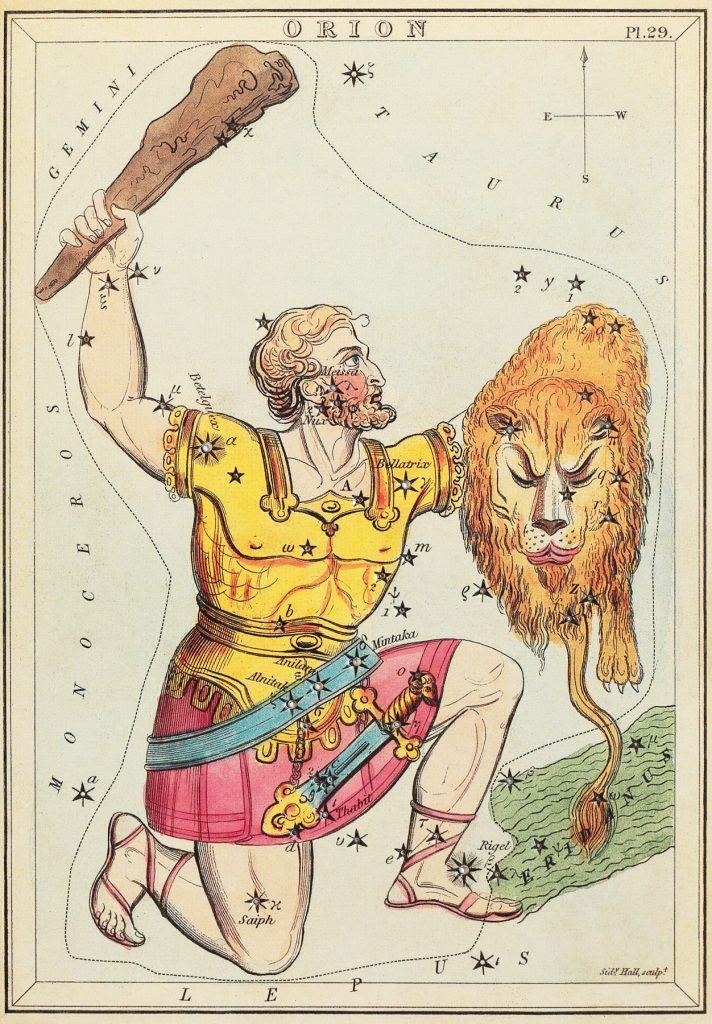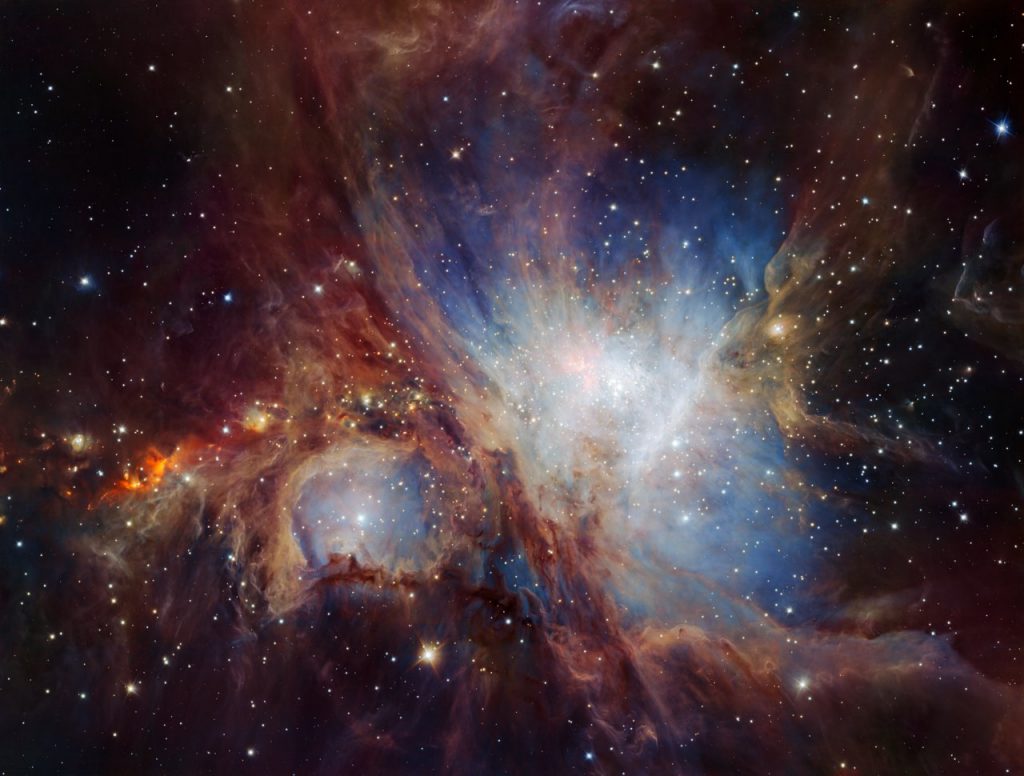As we head into summer, Orion has departed the northern nighttime skies and will reappear in the chill evenings of autumn. Looking at this distinctive constellation, we are dazzled by the bright stars that define its form: Betelgeuse, the red supergiant of Orion’s left shoulder; Rigel, the blue supergiant that marks his right leg; Saiph, the blue giant for his left leg; Bellatrix, another blue giant that marks his right shoulder and the blue giant and supergiant belt stars, Alnitak, Alnilam and Mintaka.

“Orion“, plate 29 in Urania’s Mirror, a set of celestial cards accompanied by
A familiar treatise on astronomy …by Jehoshaphat Aspin. London. (Sidney Hall, Public domain, via Wikimedia Commons)
As impressive as these stars are, there is more to three of them than meets the human eye. What we see as single stars with the naked eye are in reality multiple star systems containing from three to as many as six stars doing a celestial dance together that is governed by the laws of physics.
In the illustration below we can see that Rigel, Mintaka and Alnitak, plus an additional star system, Sigma Orionis, which lies in a cluster of stars just below the left-most belt-star, Alnitak, are multiple star systems. The Orion Nebula itself is a literal star factory containing over 3000 stars with more than 700 of them in various stages of development. There are over 150 stars in this region that have protoplanetary disks – dusty regions around the stars where planets may be forming.

Note that in the illustration the stellar orbits are not to scale, and the orientation of the orbits do not reflect the actual orientation relative to Earth, but the size of the stars displayed are to scale with the Sun’s size shown for reference. One can easily see that the Sun is dwarfed by even the smallest of these stars, which in turn are minuscule relative to the supergiant, Rigel, which is 79 times the size of our star and has 21 times the mass.
The Alnitak and Rigel systems contain pairs of stars that orbit too close together to be resolved (seen as separate stars) using the current state-of-the-art optical telescopes we have available today. These binary systems were discovered by looking at the spectrum of the stars’ light and how it shifts over time. Check out this great article on how spectral binary stars are identified. https://scienceatyourdoorstep.com/2018/05/11/spectroscopic-binary-stars/
Rigel has the most complex system in Orion with four stars. The spectra pair, Ba/Bb, orbit each other every 9.9 days and they orbit about a common center with Rigel C every 63 years. This trinary system obits about Rigel with a period of 24,000 years.
The Mintaka system has five stars in two systems: a binary consisting of Mintaka C/B, which may or may not be gravitationally part of the trinary system made up of the pair, Aa1/Aa2, with a period of 5.7 days, and Mintaka Ab, which orbits around the pair with a period of 350 years.
Alnitak’s spectra binary system, Aa/Ab, has a longer period of 7.3 years. Aa, a supergiant, is 20 times the size of our sun and has 33 times the mass. The smaller partner, Ab is 7 times the size of the sun. This pair is in orbit with a third star, B, and has an orbital period of just over 1500 years. Some references mention the possibility of another star in the group, but as of yet it has not been proven to be gravitationally bound to the system.
A less prominent star, Sigma Orionis, found within the Orion constellation contains a close binary pair Aa/Ab, which is made up of stars very similar in size and mass. (About 5 times the size of the sun.) They orbit each other every 143 days and the pair orbits another star, also similarly sized, with an orbital period of 160 years. These stars cast light on the famous Horsehead nebula of Orion.

The Orion Nebula is a vast stellar nursery filled with gas and dust which constantly feeds the growing stars. Some of these stars or protostars are cultivating disks of dust and gas that will eventually coalesce into planets. The two images below show Orion in visible light on the left and in infrared light on the right. The longer wavelengths of the infrared light pass through the dusty veil of the nebula giving us a clearer picture of what’s going on inside. Over the millennia to come, there may be many more stellar systems evolving and becoming visible as the nebular dissipates.

ESA/Hubble)

The cosmos contains so many wonders and we, with our limited senses, have barely scratched the surface to see and understand what is out there!
Till next time,
RC Davison
References:
Rigel:
THE SPECTROGRAPHIC ORBIT OF THE COMPANION TO RIGEL* (For Rigel B)
https://www.star-facts.com/rigel/
Alnitak:
https://www.aanda.org/articles/aa/full_html/2013/06/aa21434-13/aa21434-13.html
https://en.wikipedia.org/wiki/Alnitak
http://solstation.com/x-objects/alnitak3.htm
Mintaka:
Ref: A COORDINATED X-RAY AND OPTICAL CAMPAIGN OF THE NEAREST MASSIVE ECLIPSING BINARY, δ ORIONIS Aa: IV. A MULTIWAVELENGTH, NON-LTE SPECTROSCOPIC ANALYSIS. Link:
https://iopscience.iop.org/article/10.1088/0004-637X/809/2/135
Chandra article on Mintaka: https://chandra.harvard.edu/photo/2015/dori/
Sigma Orionis:
https://iopscience.iop.org/article/10.1088/0004-637X/742/1/55
https://iopscience.iop.org/article/10.1088/0004-637X/743/1/64/pdf
Orion Nebula
